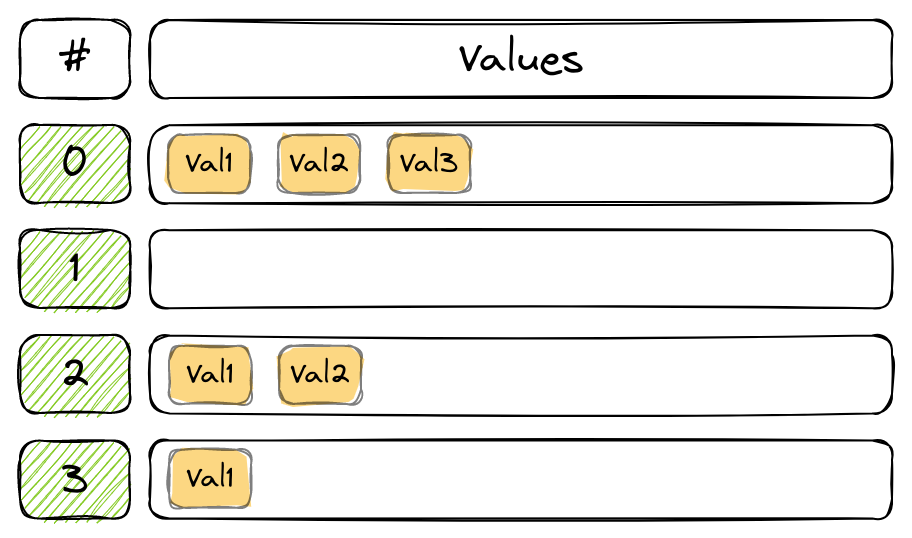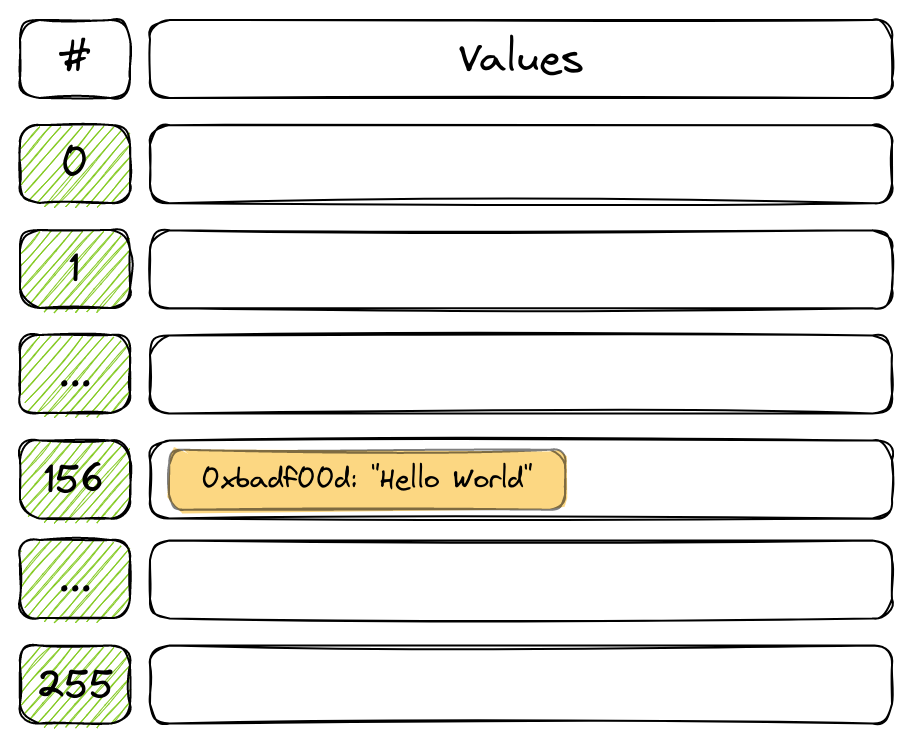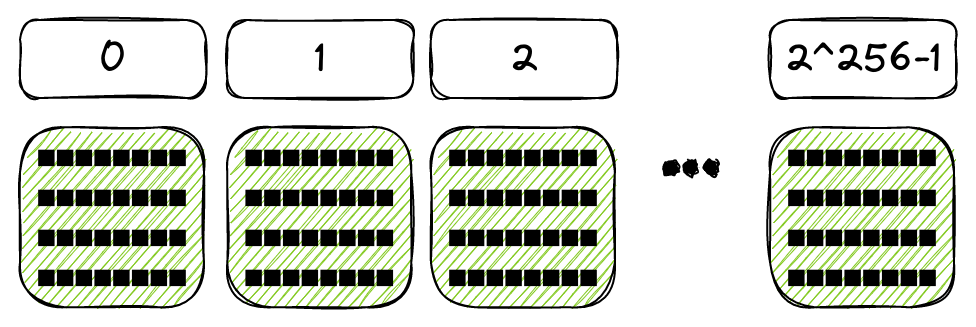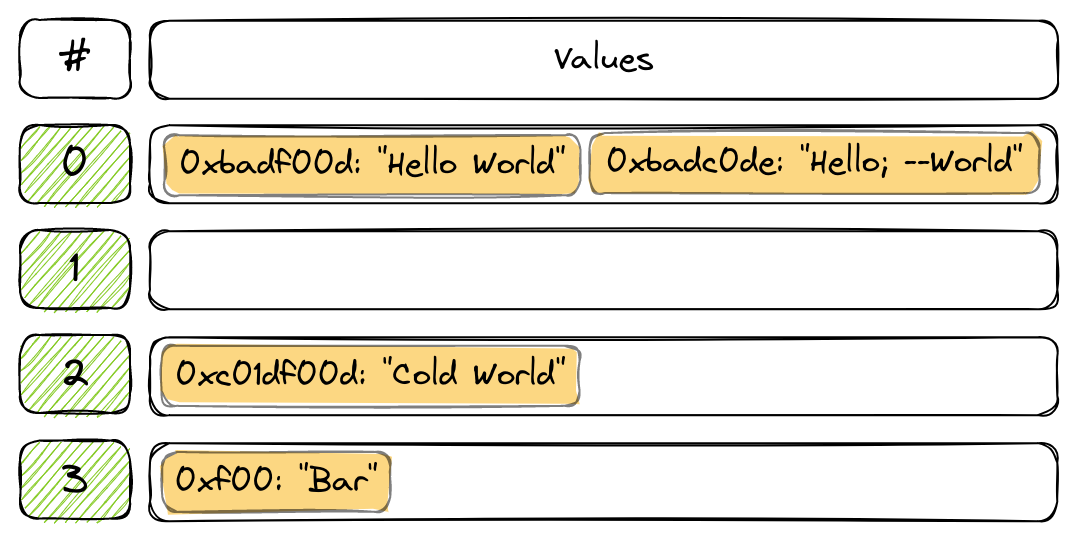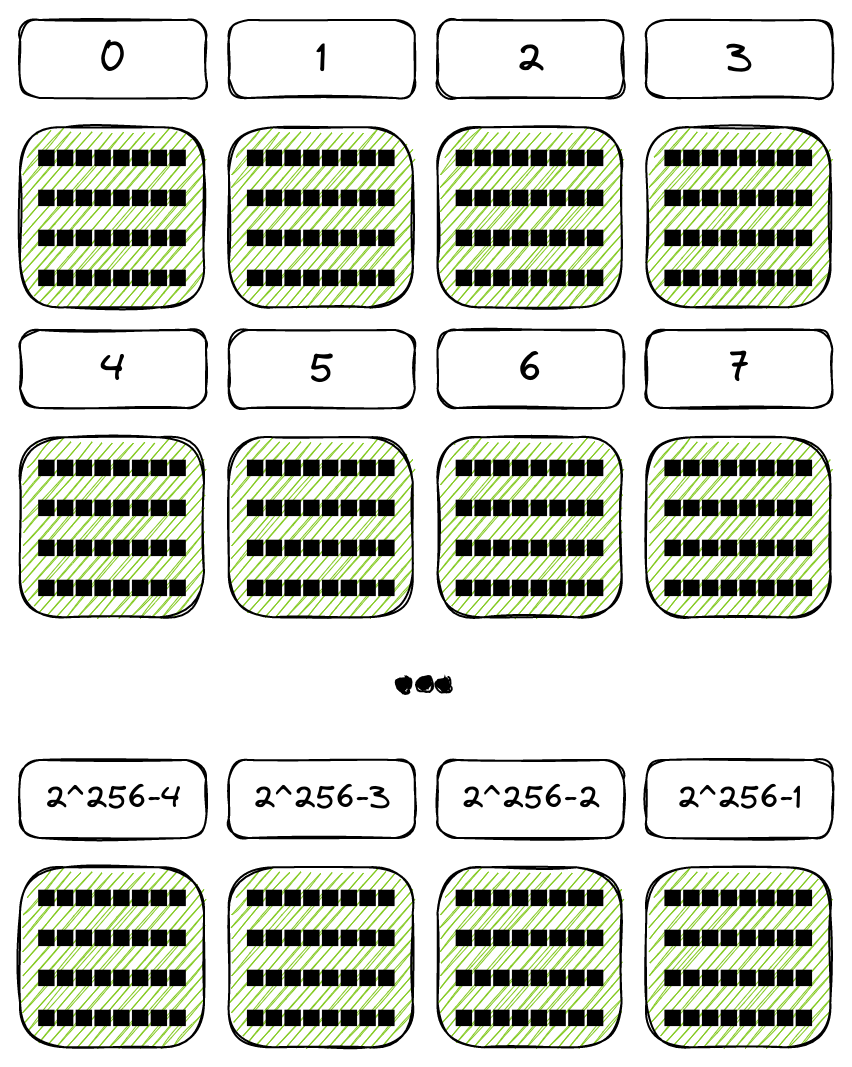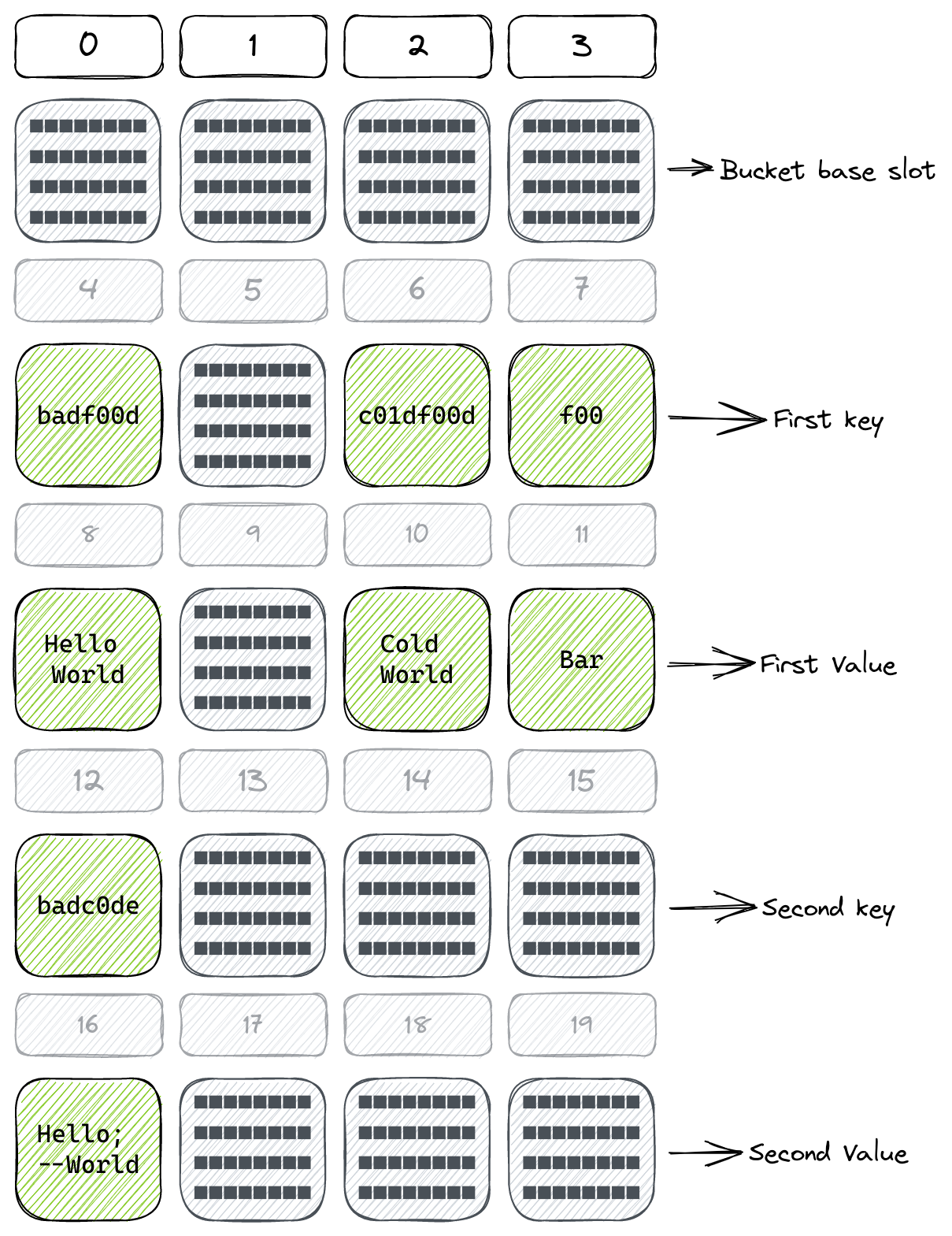#️⃣ Solidity HashMap
Solidity famously lacks complex data-structures such as HashMaps, LinkedLists,
etc. solidity-hashmap is a true HashMap implementation for Solidity.
This library is an attempt at implementing a true, efficient HashMap data-structure in Solidity which includes all the familiar API methods you'd expect a HashMap to support:
.get(key): Element.set(key, value): void.size(): uint.keys(): Element[].values(): Element[].entries(): Entry[].contains(key): bool.iterator(): HashMapIterator
The API includes multiple overloads for all value types and strings (shorter than 32 bytes). See the API section for more information.
⚠️ DISCLAIMER
This library has not been used in production. It has not been audited and might still contain serious bugs. Use at your own risk.
📖 Table of contents
📦 Installation
Depending on what toolchain you are using, you will require different installation methods.
Foundry
If you are using Foundry, install using Forge:
$ forge install tudmotu/solidity-hashmapHardhat
If you are using Hardhat, install using NPM:
$ npm i -D solidity-hashmap🤔 Why HashMap
Motivation
The mapping() data structure in Solidity provides very gas-efficient writes at
O(1), taking up 1 slot per key/value pair. This is highly efficient, but has a
serious drawback:
It is impossible to enumerate mappings and despite its name, it doesn't provide
the same API as you'd expect of a Map object in other languages.
HashMap provides an enumerable yet write-efficient data structure.
Comparison to alternatives
Two alternatives exist for HashMap:
- Solidity's builtin
mapping()data structure - OpenZeppelin
EnumerableMapimplementation
HashMap finds a balance between write-efficiency, and developer experience.
While mapping() is very efficient, it is not developer friendly and while
EnumerableMap is more developer friendly, it is not efficient.
Prefer a HashMap over EnumerableMap if you:
- Write many keys
- Rarely delete keys
- Don't need to iterate over it onchain
Gas costs comparison
| Test | HashMap | EnumerableMap | Mapping |
|---|---|---|---|
| Write a single key | 45,232 | 89,097 | 22,226 |
| Write 10k keys to map | 454,004,088 | 673,642,057 | 224,440,157 |
| Write 100k keys to map | 4,554,460,568 | 6,736,222,036 | 2,244,400,136 |
| Find a key in a 10k map | 1,252 | 524 | 249 |
| Find a key in a single key map | 1,126 | 389 | 117 |
| Iterate over 10k keys | 221,074,548 | 7,250,322 | 2,910,127 |
| Remove 10k keys | 64,816,013 | 20,970,127 | 4,390,127 |
We can see that compared to EnumerableMap, HashMap has a distinct trade-off:
it is much cheaper to write, but considerably more expensive to iterate.
Caveats
- Keys cannot be empty when converted to
bytes32:-
stringkeys cannot be empty -
int/uintkeys cannot be0
-
- Only "value" types are supported:
bytes32,uint,int,address,bool, andstring(shorter than 32 bytes) - Literal variables (numbers, strings) must be explicitly converted to their "value" types in order for the compiler to identify the correct overloads
- The
.entries(),.values()and.keys()(and their variants) are very gas-intensive and should only be used inviewfunctions called via RPC where gas is not an issue -
memoryHashMaps are not supported - A HashMap is almost O(1), but not quite. More keys means gas-efficiency might deteriorate but it will never reach O(n)
🔧 API
Import the library and use the HashMap type in your contract:
import 'solidity-hashmap/HashMap.sol';
contract Example {
HashMap tokens;
HashMap balances;
function mint (address to, uint tokenId) external {
require(tokens.get(tokenId).asAddress() == address(0));
tokens.set(tokenId, to);
balances.set(to, balances.get(to).asUint() + 1);
}
function ownerOf (uint tokenId) external returns (address owner) {
owner = tokens.get(tokenId).asAddress();
}
function balanceOf (address owner) external returns (uint balance) {
balance = balances.get(owner).asUint();
}
}.set(key, value): void
To set key/value pairs, use the .set(key, value) function. Overloads are
included for all combinations of the following types: bytes32, uint, int,
bool, address and string memory (shorter than 32 bytes).
contract Example {
HashMap hashmap;
constructor () {
hashmap.set(address(0x1ee7c0de), string("test"));
hashmap.set(string("key"), true);
hashmap.set(uint(256), -30);
hashmap.set(keccak256(hex"00"), address(0));
hashmap.set(-1, uint(420))
}
}.get(key): Element
The .get() method returns a type called Element. This type represents the
underlying value and has convenience methods for converting it into native
types. The .get() method includes overloads for the same types as .set().
contract Example {
HashMap hashmap;
constructor () {
hashmap.get(address(0x1ee7c0de)).asString();
hashmap.get(string("key")).asBool();
hashmap.get(uint(256)).asInt();
hashmap.get(keccak256(hex"00")).asAddress();
hashmap.get(-1).asUint();
}
}
Element type
The Element type represents either a key or value in the HashMap. It is
technically a wrapper around bytes32 but contains some special heuristics and
therefore should not be unwrapped directly.
The Element type exposes typed convenience methods:
.asBytes32(): bytes32.asBool(): bool.asAddress(): address.asUint(): uint.asInt(): int.asBytes(): bytes.asString(): string
HashMapIterator
To enumerate a HashMap, you use an iterator. Iterators are created by calling
.iterator() on a HashMap.
The HashMapIterator has the following API:
.hasNext(): bool.next(): Entry
You can iterate over the HashMap as long as iterator.hasNext() returns
true:
function findValueLargerThan10 (HashMap storage map) private returns (uint) {
HashMapIterator memory iterator = map.iterator();
while (iterator.hasNext()) {
Entry memory entry = iterator.next();
uint val = entry.value.asUint();
if (val > 10) return val;
}
}With an iterator, you don't need to enumerate the entire HashMap — which is very
gas-consuming — in order to find a key or a value. It's still very gas intensive
and should still be used in view functions only.
Entry memory type
The Entry type represents a key/value pair in the form of 2 Element
attributes: .key and .value. These attributes can be converted into
different native types using the Element convenience methods:
contract Example {
HashMap hashmap;
function example () public {
HashMapIterator memory iterator = hashmap.iterator();
while (iterator.hasNext()) {
Entry memory entry = iterator.next();
string memory key = entry.key.asString();
uint value = entry.value.asUint();
// You can also chain these methods
// Note: every time you call `.next()` you receive the next entry
uint aDifferentValue = iterator.next().value.asUint();
}
}
}
.keys(), .values() & and variants
The methods .keys() and .values() return an Element[] array of the
HashMap keys and values respectively.
In addition, HashMap has convenience methods that automatically convert the
Element variables into specific types:
.keysAsBytes32(): bytes32[].keysAsAddress(): address[].keysAsBool(): bool[].keysAsUint(): uint[].keysAsInt(): int[].keysAsString(): string[].valuesAsBytes32(): bytes32[].valuesAsAddress(): address[].valuesAsBool(): bool[].valuesAsUint(): uint[].valuesAsInt(): int[].valuesAsString(): string[]
.entries(): Entry[]
Returns the list of all key/value pairs in the form of an Entry[] array.
.contains(key): bool
Returns true if the key exists. Supports all the usual overloaded versions.
.remove(key): void
Removes the key/value pair from the HashMap. Supports all the usual overloaded
versions.
✨ How does HashMap work?
This implementation is not a perfect HashMap implementation. This implementation is EVM-specific and some implementation details either require workarounds, or can't be implemented without incurring high gas fees. Below is a description of the storage architecture.
The hash table
HashMap implementations are usually based on a "Hash Table". A Hash Table is a two-dimensional data structure, where each row has a "number" column and a LinkedList or array of values. The rows are numbered sequentially and the table has a specified "size" — meaning the amount of rows is limited.
The number of rows in the Hash Table is arbitrary. In non-blockchain VMs, it can even change in run-time. This implementation does not support changing the table size in run-time due to the associated gas costs.
In this implementation, we refer to the number of each row as a "bucket".
Saving values
To save a key/value pair in the Hash Table, we do two things:
- We calculate the "bucket" of the key
- We append the key/value pair at the tip of the bucket's list
To calculate the bucket of a key, we run it through keccak256(), then modulo
with the size of the Hash Table.
For example, if our Hash Table size is 256 and we want to save the key
"badf00d", we get the bucket 156:
keccak256(hex"badf00d") % 256
= 0x42c90d12a7423fdf083e3173b5158bb60b194185a3d0ca6ea9e0035e01be749c % 256
= 156We then append our key/value pair to that bucket:
Finding values
To find a value associated with a key, we need to traverse the Hash Table:
- Find the bucket of the key
- Iterate over the LinkedList until we find the key
- Fetch the associated value
This means that .get() is not a perfect O(1), but it will also never reach
O(n). This gives us a good balance between performance, memory consumption and
developer experience.
Storage Layout
Up till now, the above explanations were not specific to an EVM implementation.
So how is this actually implemented in the EVM?
HashMap utilizes a custom "storage layout". If you are unfamiliar with this concept, check out the relevant Solidity docs.
Every contract deployed on Ethereum gets its own "storage space". This storage space is composed of "slots" — individual blocks of 32 bytes. Slots are numbered sequentially and have a range of [0..2256-1]:
You can read and write from any slot using the sstore and sload EVM op
codes:
function increment () private returns (uint count) {
assembly {
count := sload(0)
sstore(0, add(count, 1))
}
}To visualize the storage layout, let's say we have a Hash Map that uses 4 buckets:
Here we see that we have 4 rows and in 3 of these rows we have stored values:
- Row #0 contains:
-
0xbadf00d: "Hello World" -
0xbadc0de: "Hello; --World"
-
- Row #1 is empty
- Row #2 contains:
-
0xc01df00d: "Cold World"
-
- Row #3 contains:
-
0xf00: "Bar"
-
The bucket for each value is not arbitrary. Remember, to determine the bucket of a key/value pair, we hash the key and modulo it by 4 (our Hash Table size).
Next step in visualizing this, is to break the storage slot space into rows, each row the length of our Hash Table size (in this case, 4):
Now, imagine a pivoted Hash Table, where each column in the storage slot space is a "bucket", while the key/value pairs are stored on subsequent rows:
This is the gist of the storage layout of a HashMap. This does not depict everything precisely, but it should help visualize the storage layout.
⌨️ Contributions
Contributions are welcome.
Please avoid opening unsolicited PRs without first discussing them in an issue.
If you encounter bugs, please report them in the repository.

